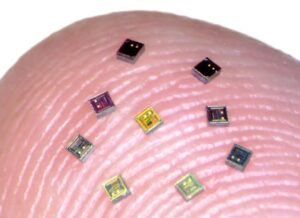Brain-Computer Interface (BCI) activated prosthetics, and other applications need sensors to provide feedback. Intensive work has been and continues to be done in this area. For example, researchers have reported their progress on an electroencephalogram (EEG)-based motor imagery BCI to control the movement of a prosthetic hand. The hand was instrumented with force and angle sensors to provide haptic feedback and local machine control. In addition to EEGs, researchers have used intracortical, electrocardiographic, and other brain signals for increasingly complex control of cursors, robotic arms, prostheses, wheelchairs, and more.
In the brain, the somatosensory cortex is responsible for receiving and processing sensory information from across the body and initiating critical movements. Located on the lateral surface of the parietal lobe (one of the brain’s five lobes located near the back and top of the head), the cortex receives tactile information including sensations such as touch, pressure, temperature, and pain. This sensory information is then transmitted to the brain through neural pathways to the spinal cord, brainstem, and thalamus.
Observing that BCI control relying on vision alone lacks a critical sensory dimension, one group of researchers supplemented vision with tactile sensing using a bidirectional brain-computer interface. The BCI records neural activity from the motor cortex and generates tactile sensations through intracortical microstimulation (ICMS) of somatosensory cortex. Torque measurements from the robotic hand controlled the stimulation of individual electrodes.
Taking a page out of the IC and packaging industries’ efforts to deconstruct complex ICs into smaller, limited-technology structures called chiplets that are easier to fabricate and test, another group of researchers chose to break up a large monolithic BCI into tiny sensors, called neurograins, that could be distributed across the cerebral cortex. The smaller BCIs can gather data from much larger groups of brain cells.
Neurograins sense electrical activity in the brain and transmit that data wirelessly. Credit: Jihun Lee / Brown University.
Several companies compete today
Today, several companies including Blackrock Neurotech, BrainGate, ClearPoint Neuro, Synchron, Neuralink and more are competing to bring brain-computer interface (BCI) technology into the marketplace. Neuralink, an Elon Musk venture, is developing an implant that would be placed in the brain through a robot-assisted procedure. The implant has a six-axis inertial measurement unit (IMU) for tracking head movement and more sensors for measurables like temperature, as well as a Bluetooth antenna to connect with a smartphone app.
How can the government help?
In May 2021, the U.S. Food and Drug Administration (FDA) issued a non-binding recommendation titled, “Implanted Brain-Computer Interface (BCI) Devices for Patients with Paralysis or Amputation.” The 44-page document identifies the key aspects of BDI devices and provides guidance for industry and FDA staff. For example, a robotic assistive effector and/or sensor component should have a description of the assistive effector and/or sensor component(s) (such as a prosthetic limb, computer, or sensors), and include:
- Model Number
- Description of modifications to the cleared or approved device(s) (for example, the addition of sensors)
- Degrees of freedom (such as the total number of independent displacements or aspects of motion) and
- Description of how the assistive effector or sensor component(s) is controlled (for example, sequential or simultaneous control of the arm joints).
In April 2021, the FDA announced market authorization for a product that uses a wireless EEG headset to help stroke patients regain arm and hand control. It became the first wearable BCI for rehabilitation to receive market authorization from the FDA. Other wearable and implanted BCIs for medical uses are currently in clinical trials.
References
https://www.researchgate.net/publication/4310337_Brain-Computer_Interface_for_a_Prosthetic_Hand_Using_Local_Machine_Control_and_Haptic_Feedback
https://www.simplypsychology.org/somatosensory-cortex.html
https://www.ncbi.nlm.nih.gov/pmc/articles/PMC8715714/
https://pubmed.ncbi.nlm.nih.gov/31751015
Wireless Microscale Neural Sensors Enable Next-Generation Brain-Computer Interface System https://scitechdaily.com/wireless-microscale-neural-sensors-enable-next-generation-brain-computer-interface-system/#:~:text=BCI%20systems%20depend%20on%20implantable,like%20computers%20or%20robotic%20prosthetics.
7 brain-computer interface companies you need to know https://www.massdevice.com/brain-computer-interface-bci-companies/
Implanted Brain-Computer Interface (BCI) Devices for Patients with Paralysis or Amputation – Non-clinical Testing and Clinical Considerations Guidance for Industry and Food and Drug Administration Staff https://www.fda.gov/regulatory-information/search-fda-guidance-documents/implanted-brain-computer-interface-bci-devices-patients-paralysis-or-amputation-non-clinical-testing
https://www.gao.gov/products/gao-22-106118

